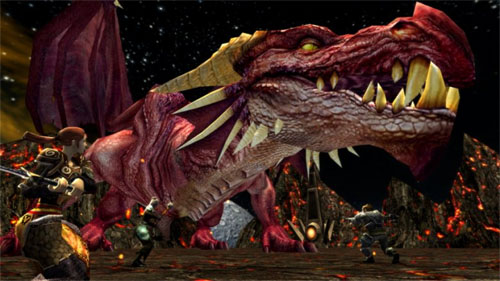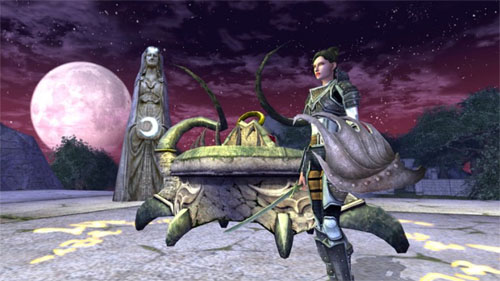We’re continuing with MMO Co-Opportunities with another Turbine game: Dungeon and Dragons Online (or DDO). It’s been quite awhile since I played this game (back when I played it was still a subscription-based MMO), so I’m sure that much of my information is outdated; however, there was a great co-op feel to the game that I’m positive is still alive and well in its current form.
Many of today’s RPG and MMO players still come from a pen-and-paper RPG background. DDO embraced that fact and sought to create an MMO that felt and played like its pen-and-paper namesake. Whether Turbine succeeded at this or not is purely subjective, but I strongly feel that at the very least they delivered 100% on the feeling of camaraderie and teamwork that the paper version inspired in so many of its players. In no other MMO have I felt like such an integral part of a team, nor have I felt like my party must truly adapt to the changes and challenges presented as a unit, or suffer having to do it all over again. In this edition, we salute DDO’s team-based gameplay and strong community.

I played DDO with three other friends and pressed through a large majority of the content available at that time with the same team. Right from the start, it became apparent that DDO made no promises of not being a team-focused game. Turbine had recently added in a solo difficulty to its various dungeons so players could adventure alone, but the rewards were much greater if you completed the dungeons on harder difficulties, and for that you required teammates. We did our pre-game research and found out what made for a good group composition and settled for a tank-type, a sorcerer, a cleric, and me on a rogue for trap support. From there we set forth to kill kobalds (“yark, yark, yark!”), oozes (don’t use a sword on them, unless you want them to split), and skeletons (use a mace on these).
The first week or so was... rough. We had come from some kind of fast-paced, action-oriented MMO (I don’t remember which one) straight into the heart of DDO where conservation, forsight, patience, and above all communication ruled. Mana points did not regenerate when in a dungeon. Many skills had a certain number of times you could use them in a dungeon. If you were going to buff, you had to decide which buffs on whom were worth the mana. If you were going to heal, you had to decide whether this was the time for a greater or lesser heal. Crowd control (CC) was an absolute necessity, and woe to the party who broke the CC haphazardly. There were mp and hp shrines throughout dungeons (the smaller ones might only have one, but the very, very long ones might have three), but each shrine could only be used once per player. You had to choose whether now was a good time to use it, or if it would be wiser to save it and backtrack later.

Though I liked and disliked some of these features more than others, it was these types of characteristics that made communication and teamwork so crucial. Your party members had to know which mobs were being CC’ed and which mobs were being taken down first. Groups had to stick together in most areas so the rogue could detect nasty traps, and said rogue had to be quick to communicate when he or she saw a trap. Trust played a large role in DDO; you had to be able to trust that your party members had your back and would let you know if the plan needed to change. When your party suddenly came face-to-face with a Beholder or Mindflayer, it was unite or die, as over-dramatic as that sounds.
